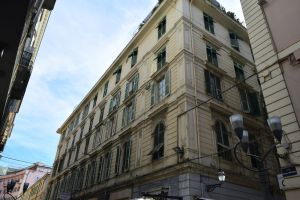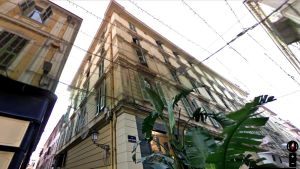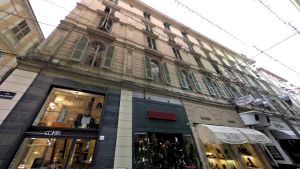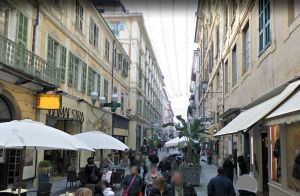A stately building in the city centre
The construction of the palace was undertaken in the 1870s by Marquis Camillo Pallavicini in what was then Via Vittorio Emanuele II on the corner of Via Gaudio (now Via Matteotti with the main entrance at  number 178) to provide his family with a prestigious residence in the centre of the city.
number 178) to provide his family with a prestigious residence in the centre of the city. Two projects were presented for the building: one by the Savoy engineer Adolfo Quentin on 25 March 1871, and the other by the Genoese engineer Nicolò Bruno on 14 March 1876.
Two projects were presented for the building: one by the Savoy engineer Adolfo Quentin on 25 March 1871, and the other by the Genoese engineer Nicolò Bruno on 14 March 1876.
In the first, the use of rather light architectural solutions, typical of the urban structure of Paris and even more so of the Côte d'Azur, was evident, characterised by the use of large glass surfaces on the ground floor, ideal for elegant shops and restaurants, with decorative applications dating back to early iron architecture.
The project launched by engineer Bruno, who had already designed important buildings in Genoa and Trieste, envisaged the construction of a palace characterised by smooth ashlar work and a neo-Renaissance architectural style, visible above all in the particularly austere and essential forms of the severe and imposing façade. In the end, the solution proposed by Bruno proved to be more in keeping with the Marquis Pallavicini's need for representation, and was also perfectly in line with the increasingly widespread tendency to consider Via Vittorio Emanuele as the city's "good living room", very different from the seaside boulevard that was then becoming popular in coastal tourist resorts.
In the end, the solution proposed by Bruno proved to be more in keeping with the Marquis Pallavicini's need for representation, and was also perfectly in line with the increasingly widespread tendency to consider Via Vittorio Emanuele as the city's "good living room", very different from the seaside boulevard that was then becoming popular in coastal tourist resorts. After the final approval of the project by the Deputazione Provinciale di Porto Maurizio on 31 May 1876, the building was completed in 1877, while the following year Pallavicini opened up what is now Via Piave on the western side of his palace. In the first years after its construction, the Pallavicini residence was known above all for the fact that its ground floor housed a 'reading cabinet' with the most famous and prestigious foreign newspapers of the time and a large room for conversation and recreational activities.
After the final approval of the project by the Deputazione Provinciale di Porto Maurizio on 31 May 1876, the building was completed in 1877, while the following year Pallavicini opened up what is now Via Piave on the western side of his palace. In the first years after its construction, the Pallavicini residence was known above all for the fact that its ground floor housed a 'reading cabinet' with the most famous and prestigious foreign newspapers of the time and a large room for conversation and recreational activities.
The building is currently used as the headquarters of various commercial and recreational activities, offices, hotels and private homes.
(sources: text by Andrea Gandolfo; images from private archives)




